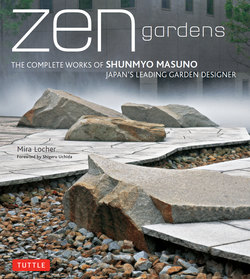Читать книгу Zen Gardens - Mira Locher - Страница 9
На сайте Литреса книга снята с продажи.
ОглавлениеNotes on Language
Japanese names in the text are written to follow the typical Japanese order of the family name followed by the given name (the opposite of English). An exception is Shunmyo Masuno’s name which is written with his given name, Shunmyo, followed by his family name, Masuno. Shigeru Uchida's name is treated similarly.
Japanese words used in the text are written in Roman script (romaji), based on phonetic pronunciation using a modified Hepburn system. Consonants are pronounced similarly to English, with g always hard. A macron is used to denote a long vowel sound, except for words such as Tokyo and Kyoto, which have become common in English, and the word torii, which is commonly written with ii rather than ī. An exception is Kenkohji, the temple where Masuno presides as head priest, which uses an h following the o rather than a macron. Vowels are pronounced as follows:
a is ă as in father (ā denotes a lengthened sound; also written as aa)
i is ē as in greet (ī denotes a lengthened sound; also written as ii)
u is ū as in boot
e is ĕ as in pet (also written as é)
o is ō as in mow (ō denotes a lengthened sound, also written as oo or ou).
The glossary includes Japanese characters for each word—kanji ideographs originally from China and the two kana syllabaries based on phonetics, hiragana (now used for Japanese words or parts of words for which there is no kanji) and katakana (now used primarily for foreign words).
Japanese nouns can be either plural or singular.
For clarity, I have included the word temple following the name of a temple, for example “Ryōanji temple” and “Daisenin temple,” even though ji in Ryōanji and in in Daisenin mean "temple." Similarly, the word garden may follow the name of a garden, as in “Yūkyūen garden” or “Baikatei garden,” although en and tei mean "garden."
I utilize the definitions of rock and stone laid out by David A. Slawson in Secret Teachings in the Art of Japanese Gardens: Design Principles and Aesthetic Values (p. 200). He states, “Japanese ishi (seki) I translate as 'rock(s)' when they are used in the garden to suggest rock formations in nature, and 'stone (s)' when they are used (for their naturally or artifi-cially flattened upper surfaces) as stepping-stones or paving stones, or when they have been sculpted (stone lanterns, water basins, pagodas) or split or sawed (stone slabs used for bridges, paving, curbing).”
